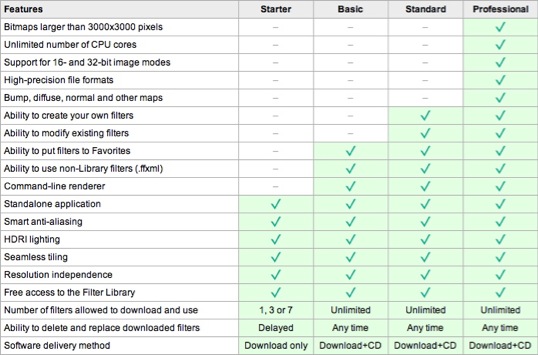CityEngine 2009.2 procedural modeler released
16/09/09 11:01 Filed in: News
New CityEngine 2009.2 Version Available Now for Download!
Significant improvements in performance allow for the design and modeling of megacities with over 500'000 buildings.
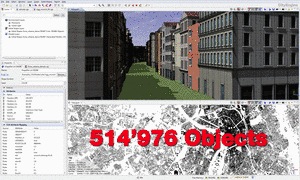
Procedural Inc. today announced the CityEngine 2009.2, the latest version of its groundbreaking software for the fast creation, visualization and analysis of large 3D cities. The software is used by high-profile companies such as Foster+Partners, Microsoft, Navteq, Boeing, IBM, Thales, Blizzard, Square Enix, etc. and was awarded Killer Technology 2009 by 3D World magazine Procedural Inc., an innovative software company located in Zurich, Switzerland, is creator of the world’s foremost procedural modeling technology. With the CityEngine, Procedural Inc.’s graphics experts have developed a radically different 3D application that allows professional users in entertainment, architecture and urban planning to efficiently design cities. "CityEngine 2009.2 introduces significant improvements in performance and overall stability", says Pascal Mueller, CEO Procedural Inc. "Furthermore, with the integration of map projection standards and corresponding accuracy enhancements, the CityEngine is now, together with its unique reporting functionality, the perfect tool for sustainable urban planning such as accurate simulation and evaluation of new city developments."
Key Highlights of the CityEngine 2009.2
- Large Data Set Support (over 500'000 buildings on 64bit)
- Map Projections (over 80 projections are supported)
- Accuracy Enhancements (enabling high-precision at global scale )
- 3DS Export (plus advancements of Collada and FBX export)
Pricing and Availability
A free 30-day trial version is available for download. The software can be purchased via Procedural Inc.’s website, or by telephone order at +41 76 720 3303. The CityEngine retails from a starting price of $ 3’450.
CityEngine Review
26/07/09 12:31
CityEngine
Incredibly powerful urban habitation modeling tool
by Albert Kiefer
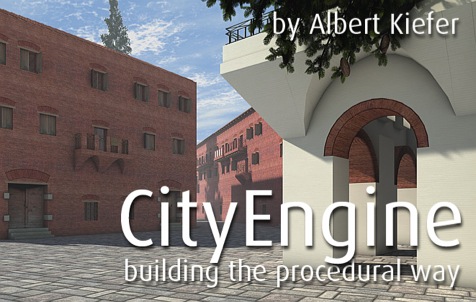
Both in Architectural visualizations, in certain games situations but also in archeologic reconstructions it is sometimes inevitable to create or recreate an urban environment. A habitated area that shows human presence. Historically this habitation grows from a number of conditions present at a certain geographic location such as a path, a road, a river, etc. People will start settling in places like these and build houses and streets along trading routes that establish themselves in a village that evolves into a town and than maybe into a huge metropolitan city.
Swiss company Procedural have developed a software specifically for this purpose and it’s doing a fantastic job at it. However it’s not your regular easy drag and drop type of software. Obviously CityEngine does provide a great drag and drop functionality. It supports this by dragging rules based procedures to pre-selected surface areas. But it is by no means a software for the casual user. Obviously at its price point starting at 3450 US Dollars (there is an educational license for just 695 US Dollars), this software is not intended for the casual user but for professionals in the architecture, games, film, archeologic and general visualization companies for which the seemingly steep pricing is not a problem since the software will earn itself back very quickly.
Procedurally Structured
So how does CityEngine work its magic? Well it starts more or less the same way a city develops over time. So basically it starts from simple road network. You can for example import xml, dxf data from any source (like openstreetmap.org) and start building from these street networks, or you can have CityEngine generate a network for you based on a series of procedural rules.
After the network is generated you can command CityEngine to draw lots between those streets. These can be subdivided further in smaller lots. After this process of subdivision is complete (you can, by selecting areas, constrain the generation of lots to areas you like) CityEngine can start drawing buildings onto each individual lot or to sets of lots that you pre select. This process is very straightforward and in no time you have created a very convincing urban area with lots of different buildings.
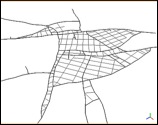
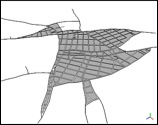
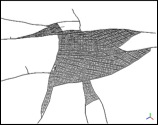
from basic street network to elaborate lot subdivision is just a simple three click process
Now generating networks of streets and subdividing the areas between these streets with small lots of ground is nice. But obviously there, where the houses start to build themselves is where the real CityEngine magic starts to work. CityEngine does this by a procedural modeling language and they have called this modelling structure the Shape Grammar. In the shape grammar of a particular building they write down a set of rules that geometry, and even texturemaps, will behave to depending on a specific situation. This way you can create stunningly adaptive buildings that seems to just know how to behave under certain conditions.
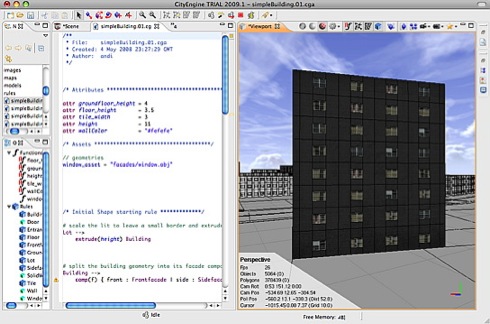
a section of shape grammar code next to a building (might not be the building for this code)
Make a building taller and it automatically adds new floors to compensate for the extended height. Make it wider and the structure adds more windows to avoid large blind walls.
In their free 30 day demo version they have a set of shape grammar scripts to recreate the Petronas Towers, the Parthenon and the Candler building. That way you can start to dissect how to work with this procedural scripting language.
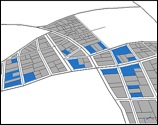
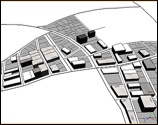
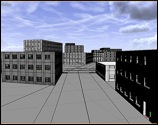
by selecting subdivided lot sections each can be assigned instructions via shape grammar rules
CityEngine is very powerful for games development too because it can simultaneously generate different levels of details (for instance for distant buildings in relation to a player, or for a simpler collision detection geometry model). And it can export in a variety of formats for popular games engines.
All in all CityEngine is a very powerful package for modeling and simulating urban civilizations. They have even done a great job of rebuilding ancient Pompei (take a look at that movie here). It’s even a great conceptual tool for quickly investigating different massing and shape strategies by architects. But it is certainly not for the casual user. They have now expanded their terrain to include a Mac version as well but I have had serious issues with both the graphics engine and professional Mac video card (ATI Radeon X1900 XT with 512Mb Vram) and also Mac formatted xml files exported from open streetmap (it just does not read them because of a different file naming structure. In my case I had to disable the CityEngine shader on my MacPro 8 core Xeon system because it basically stopped interacting with even a one house shaded setup.
I can even very well see a lower cost version being developed that will sell based on selling rules sets for buildings and simulated streets and lots in a more consumer oriented way wich will certainlly find its way to broader user base.
Incredibly powerful urban habitation modeling tool
by Albert Kiefer

Both in Architectural visualizations, in certain games situations but also in archeologic reconstructions it is sometimes inevitable to create or recreate an urban environment. A habitated area that shows human presence. Historically this habitation grows from a number of conditions present at a certain geographic location such as a path, a road, a river, etc. People will start settling in places like these and build houses and streets along trading routes that establish themselves in a village that evolves into a town and than maybe into a huge metropolitan city.
Swiss company Procedural have developed a software specifically for this purpose and it’s doing a fantastic job at it. However it’s not your regular easy drag and drop type of software. Obviously CityEngine does provide a great drag and drop functionality. It supports this by dragging rules based procedures to pre-selected surface areas. But it is by no means a software for the casual user. Obviously at its price point starting at 3450 US Dollars (there is an educational license for just 695 US Dollars), this software is not intended for the casual user but for professionals in the architecture, games, film, archeologic and general visualization companies for which the seemingly steep pricing is not a problem since the software will earn itself back very quickly.
Procedurally Structured
So how does CityEngine work its magic? Well it starts more or less the same way a city develops over time. So basically it starts from simple road network. You can for example import xml, dxf data from any source (like openstreetmap.org) and start building from these street networks, or you can have CityEngine generate a network for you based on a series of procedural rules.
After the network is generated you can command CityEngine to draw lots between those streets. These can be subdivided further in smaller lots. After this process of subdivision is complete (you can, by selecting areas, constrain the generation of lots to areas you like) CityEngine can start drawing buildings onto each individual lot or to sets of lots that you pre select. This process is very straightforward and in no time you have created a very convincing urban area with lots of different buildings.



from basic street network to elaborate lot subdivision is just a simple three click process
Now generating networks of streets and subdividing the areas between these streets with small lots of ground is nice. But obviously there, where the houses start to build themselves is where the real CityEngine magic starts to work. CityEngine does this by a procedural modeling language and they have called this modelling structure the Shape Grammar. In the shape grammar of a particular building they write down a set of rules that geometry, and even texturemaps, will behave to depending on a specific situation. This way you can create stunningly adaptive buildings that seems to just know how to behave under certain conditions.

a section of shape grammar code next to a building (might not be the building for this code)
Make a building taller and it automatically adds new floors to compensate for the extended height. Make it wider and the structure adds more windows to avoid large blind walls.
In their free 30 day demo version they have a set of shape grammar scripts to recreate the Petronas Towers, the Parthenon and the Candler building. That way you can start to dissect how to work with this procedural scripting language.



by selecting subdivided lot sections each can be assigned instructions via shape grammar rules
CityEngine is very powerful for games development too because it can simultaneously generate different levels of details (for instance for distant buildings in relation to a player, or for a simpler collision detection geometry model). And it can export in a variety of formats for popular games engines.
All in all CityEngine is a very powerful package for modeling and simulating urban civilizations. They have even done a great job of rebuilding ancient Pompei (take a look at that movie here). It’s even a great conceptual tool for quickly investigating different massing and shape strategies by architects. But it is certainly not for the casual user. They have now expanded their terrain to include a Mac version as well but I have had serious issues with both the graphics engine and professional Mac video card (ATI Radeon X1900 XT with 512Mb Vram) and also Mac formatted xml files exported from open streetmap (it just does not read them because of a different file naming structure. In my case I had to disable the CityEngine shader on my MacPro 8 core Xeon system because it basically stopped interacting with even a one house shaded setup.
I can even very well see a lower cost version being developed that will sell based on selling rules sets for buildings and simulated streets and lots in a more consumer oriented way wich will certainlly find its way to broader user base.
Filter Forge Review
30/06/09 14:02
an indispensible tool for the graphic and 3D artist
by Albert Kiefer
Recently I received a message via one of my feeds that Filter Forge was finally released for Mac OS X.
Previously only availbe for windows systems I have long eyed the special application with envy. The sheer possibilities of this seemingly small application are endless. As a visual designer this enables me a lot of freedom building up images.
Stand Alone and Photoshop Plug-In
Filter Forge is a procedural texture generator and Image manipulator in one app (or Plug-In) that has a tremendous flexibility. The advantage of the Plug-In is that you can apply filter effects directly to any image you are currently working on in Photoshop without having to resort to pointing Filter Forge to an image explicitly. The other advantage is that you can apply the effects to a selected area.
The advantages of the stand alone version are that you are not bogged down by Photoshop and several windows and that you can start to create your own filters from scratch.
Image Correction and Manipulation
Filter Forge can either do basic to advanced color correction or abstraction on any of your images (just create a workflow and save it with several presets) or it can combine the image information with very complex procedural calculations that turn images into fantastic pieces of abstracted, grunged up or plain funny works of art.

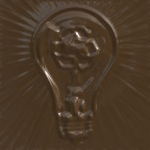




Incredibly powerful texture engine
For me however the most incredible power lies in Filter Forge’s ability to create stunning and versatile seamless textures that are very, very handy to apply as texturemaps in 3D software. The thing is that produral textures are a common sight in any 3D software nowadays but they sometimes generate such complex textures that rendering an animation slows down to a crawl due to time and time again calculating these complex procedurals every frame.
With Filter Forge you can create the same, if not much more complex and convincing textures and, once they are rendered to a tileable image file, you have a file that renders like lightning and even will behave better with anti-aliasing than some procedural noises ‚in app’ tend to do.
But Filter Forge does not simply spit out an image file. It even presents you with the options of generating normal maps, bump maps and specular maps and alpha channels of that same file. This way you have a complete package of images to put to use in you texturing project.

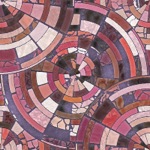
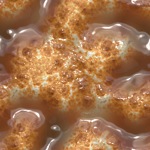
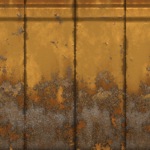
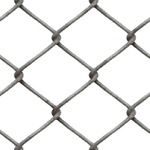
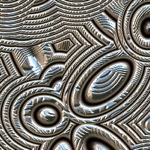
All of the above images are procedural without any additional image input.
Library Magic
When you get Filter Forge and open it up for the first time you cannot even start to comprehend how powerful this app actually is. So first thing I would advise is to rus over to their very extensive on-line libraries and grab presets from several categories. You can spend hours and hours just marveling at the incredible images and textures that are being generated by a very active user community and wich are free to download (you can even do that directly into you running Filter Forge app!)
Multi-core enabled
The node based system that Filter Forge uses to create its magic can bring down a modern computer if things get really complicated (but remember: it’s only once to render the image and then the resulting image renders blindingly fast in your 3D package of choice). So the developers have enabled multi-core rendering. If you happen to have more than one processor driving your machine you can put that extra power to great use here.

The node based system lays out steps in clear iconic building blocks.
Variations to go
Filter Forge comes in several flavors tailored to your specific preference or budget.
- Filter Forge Starter-1 Edition Mac ($ 9.-)
- Filter Forge Starter-1 Edition WIN ($ 9.-)
- Filter Forge Starter-3 Edition Mac ($ 19.-)
- Filter Forge Starter-3 Edition WIN($ 19.-)
- Filter Forge Starter-7 Edition Mac ($ 29.-)
- Filter Forge Starter-7 Edition WIN ($ 29.-)
- Filter Forge Basic Edition Mac ($ 99.-)
- Filter Forge Basic Edition WIN ($ 99.-)
- Filter Forge Standard Mac ($ 199.-)
- Filter Forge Standard WIN ($ 199.-)
- Filter Forge Professional Mac ($ 299.-)
- Filter Forge Professional WIN ($ 299.-)
